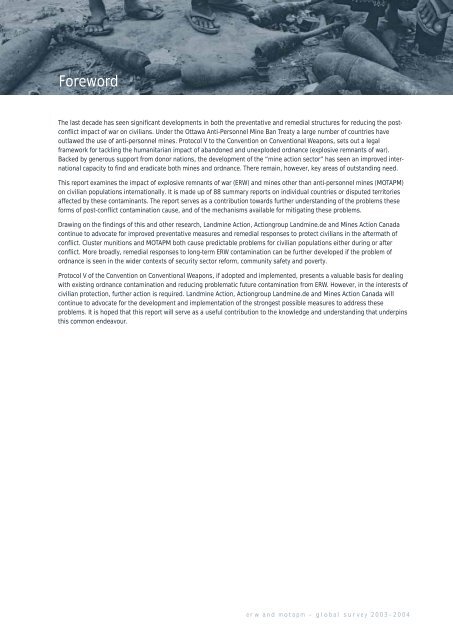Country & Territory Reports - Landmine Action
Country & Territory Reports - Landmine Action
Country & Territory Reports - Landmine Action
Create successful ePaper yourself
Turn your PDF publications into a flip-book with our unique Google optimized e-Paper software.
Foreword<br />
The last decade has seen significant developments in both the preventative and remedial structures for reducing the postconflict<br />
impact of war on civilians. Under the Ottawa Anti-Personnel Mine Ban Treaty a large number of countries have<br />
outlawed the use of anti-personnel mines. Protocol V to the Convention on Conventional Weapons, sets out a legal<br />
framework for tackling the humanitarian impact of abandoned and unexploded ordnance (explosive remnants of war).<br />
Backed by generous support from donor nations, the development of the “mine action sector” has seen an improved international<br />
capacity to find and eradicate both mines and ordnance. There remain, however, key areas of outstanding need.<br />
This report examines the impact of explosive remnants of war (ERW) and mines other than anti-personnel mines (MOTAPM)<br />
on civilian populations internationally. It is made up of 88 summary reports on individual countries or disputed territories<br />
affected by these contaminants. The report serves as a contribution towards further understanding of the problems these<br />
forms of post-conflict contamination cause, and of the mechanisms available for mitigating these problems.<br />
Drawing on the findings of this and other research, <strong>Landmine</strong> <strong>Action</strong>, <strong>Action</strong>group <strong>Landmine</strong>.de and Mines <strong>Action</strong> Canada<br />
continue to advocate for improved preventative measures and remedial responses to protect civilians in the aftermath of<br />
conflict. Cluster munitions and MOTAPM both cause predictable problems for civilian populations either during or after<br />
conflict. More broadly, remedial responses to long-term ERW contamination can be further developed if the problem of<br />
ordnance is seen in the wider contexts of security sector reform, community safety and poverty.<br />
Protocol V of the Convention on Conventional Weapons, if adopted and implemented, presents a valuable basis for dealing<br />
with existing ordnance contamination and reducing problematic future contamination from ERW. However, in the interests of<br />
civilian protection, further action is required. <strong>Landmine</strong> <strong>Action</strong>, <strong>Action</strong>group <strong>Landmine</strong>.de and Mines <strong>Action</strong> Canada will<br />
continue to advocate for the development and implementation of the strongest possible measures to address these<br />
problems. It is hoped that this report will serve as a useful contribution to the knowledge and understanding that underpins<br />
this common endeavour.<br />
erw and motapm – global survey 2003–2004


